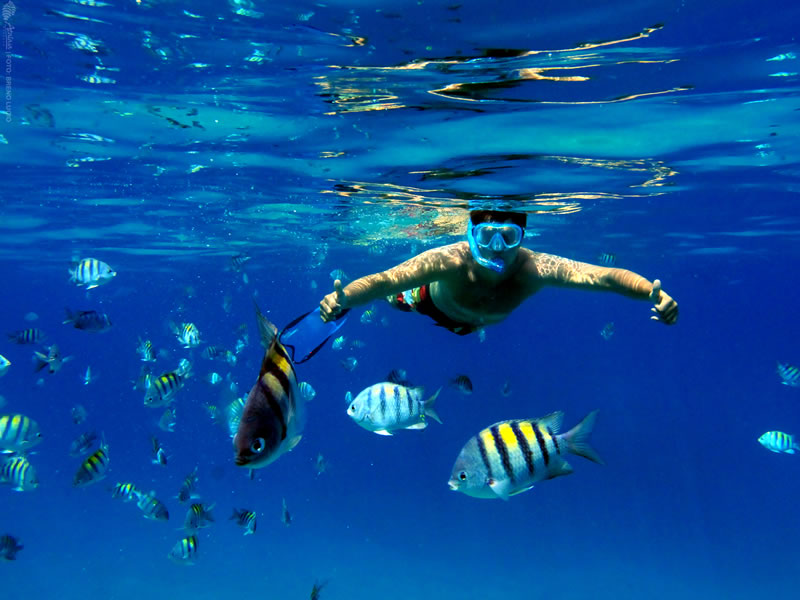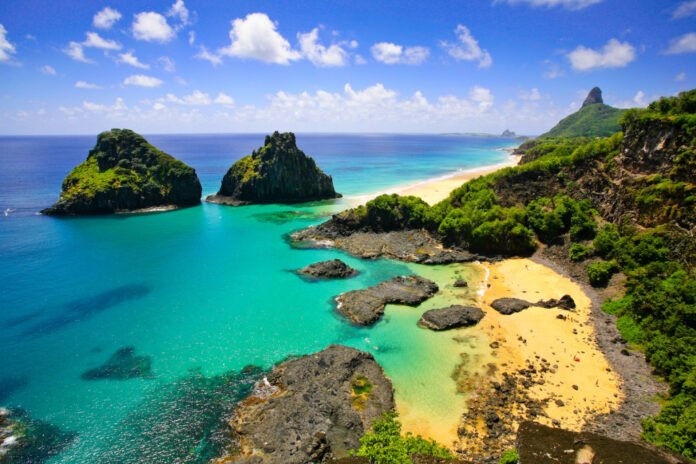Fernando de Noronha, a stunning volcanic archipelago, is situated in the Atlantic Ocean about 350 kilometers off Brazil’s northeast coast, within the state of Pernambuco. Founded on August 10, 1503, by Amerigo Vespucci, this breathtaking location encompasses a total area of 26 square kilometers and is home to a population of 3,101. The archipelago consists of 21 islands and islets, along with volcanic rock formations. Some of the notable islands include Rata, Sela, Gineta, Cabeluda, and Sao Jose, while islets like Leao and Viuva add to the archipelago’s charm. The highest point on the main island is called Quixaba.
The official language of Fernando de Noronha is Portuguese, and the currency is the Brazilian Real. The majority of the population practices Catholicism.
A Safe Haven
Renowned for its safety, Fernando de Noronha is considered one of the safest beach destinations in the world. Unlike many other regions in Brazil, safety concerns are minimal here. The archipelago’s name, derived from Portuguese aristocracy, reflects its historical ties to Portugal and other former Portuguese colonies such as India, Mozambique, Angola, and Macau.
Best Time to Visit
The ideal time to visit Fernando de Noronha is between July and October, perfect for surfing and diving in its turquoise waters. The archipelago also celebrates New Year and Carnival in February, making it a lively yet busy time with rougher seas and fully booked hotels.
Unique Administration and Environmental Significance
Fernando de Noronha is administratively unique and was designated a UNESCO World Heritage site in 2001 due to its environmental importance. The time zone for the archipelago is UTC-02:00 year-round.
Biodiversity
Fernando de Noronha boasts a rich array of endemic species. The United Nations Environment Program lists 15 possible endemic plant species, including varieties of Capparis, Ceratosanthes, Cayaponia, Moriordica, and Cereus. The islands are also home to two endemic bird species: the Noronha elaenia and the Noronha vireo. Additionally, an endemic subspecies of the eared dove, endemic seabirds like the sigmodontine rodent, and two endemic reptiles—the Noronha worm lizard and the Noronha skink—inhabit these islands. The marine life, featuring sea turtles, cetaceans (dolphins and whales), and albatrosses, is a major attraction.
Climate In Fernando de Noronha
Fernando de Noronha experiences a tropical wet and dry climate, with two distinct seasons. The rainy season lasts from February to July, while the dry season spans from August to January. Temperatures range from 77°F to 86°F year-round, rarely dipping below 75°F or exceeding 89°F. The best time to visit is during the dry season from August to January.
Tourism
Tourism in Fernando de Noronha centers around its stunning beaches, ideal for recreational diving. Popular diving spots include Baia do Sancho, Pig Bay, Dolphins Bay, Sueste Bay, and Praia do Leao. The south equatorial current brings warm waters from Africa, allowing for dives up to 30-40 meters without a wetsuit and offering underwater visibility of up to 50 meters. The Atlantic-facing beaches, such as Praia do Leao, Praia do Sueste, and Praia do Atalaia, are complemented by the mainland-facing tourist beaches like Baia do Sancho, Baia dos Porcos, Praia da Cacimba do Padre, and Praia dos Americanos.
Fernando de Noronha is a paradise waiting to be explored, offering unparalleled natural beauty and unique experiences both above and below the sea.


